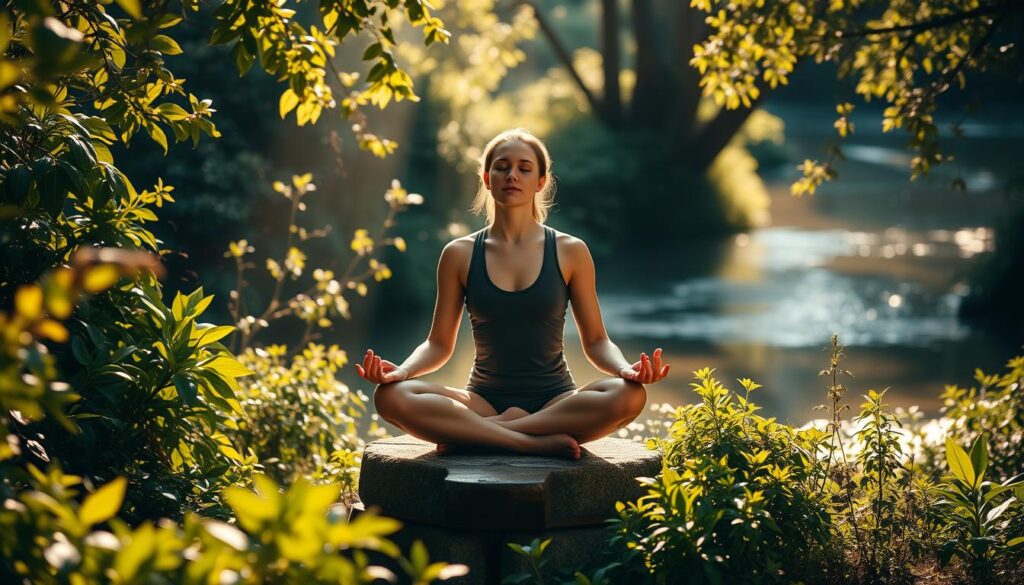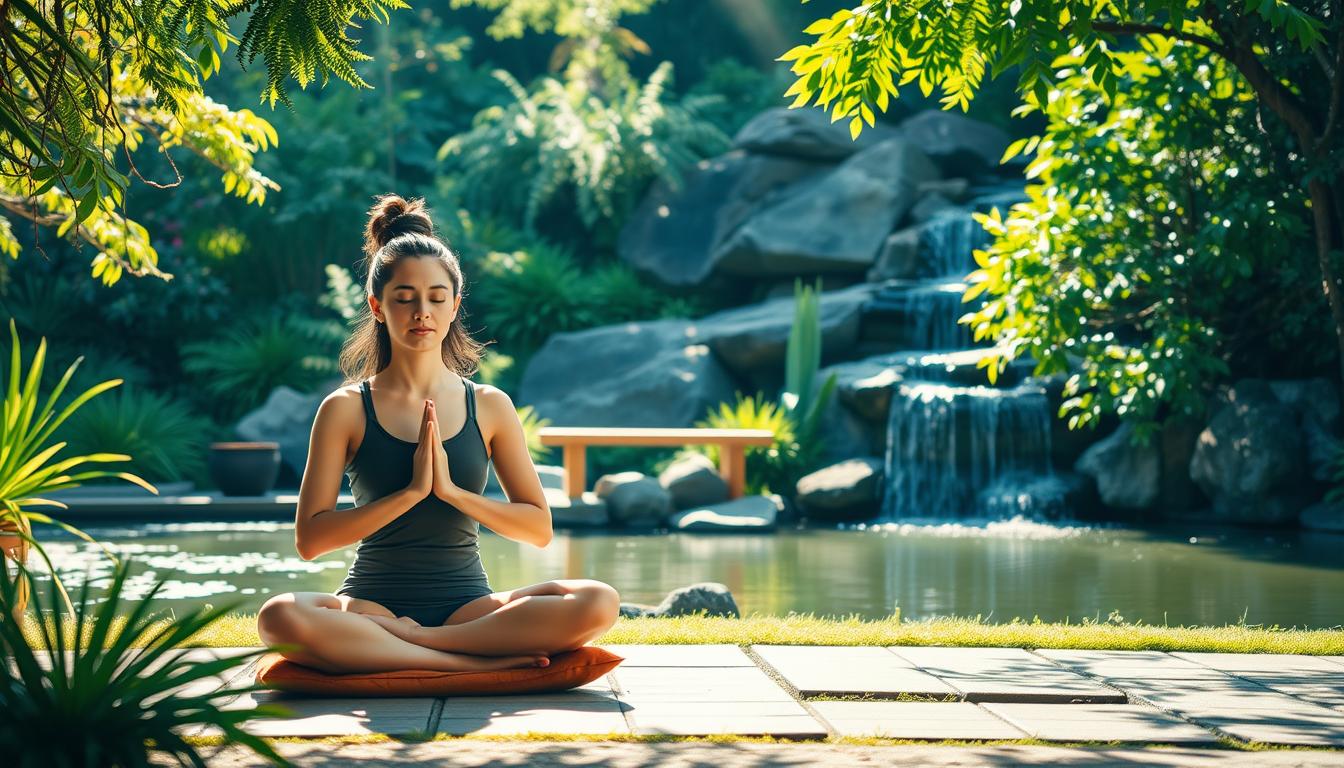I’ve been there – caught in the vicious cycle of anxiety, feeling like I’m drowning in my own thoughts. But then I discovered meditation, and it has been a total game-changer. At first, I was skeptical – could just sitting quietly really help with the overwhelming feeling of anxiety? But after experiencing stress-induced panic attacks, I realized that meditation is backed by serious science.
As someone who has struggled with anxiety, I’ve found that meditation is not just some “woo-woo” practice, but a practical tool that can literally change how our brains respond to stress. In this article, I’ll share how meditation has helped me manage anxiety, and explore different types of meditation that target anxiety symptoms, from quick breathing techniques to deeper practices that reshape our relationship with anxious thoughts.
Key Takeaways
- Discover how meditation can help decrease anxiety and improve mental wellbeing
- Learn different types of meditation practices that target anxiety symptoms
- Understand the science behind how meditation affects our brains and stress response
- Find practical ways to incorporate meditation into your daily life, even with a busy schedule
- Get started with simple meditation techniques to manage stress and anxiety
Understanding Anxiety and Its Impact on Wellbeing
When we talk about anxiety, we are also talking about our overall wellbeing. Anxiety is more than just feeling stressed or worried; it can deeply affect our health and body, creating a ripple effect that impacts every aspect of our lives.
For instance, when I first experienced panic attacks, I was struck by how physically overwhelming they were – my heart racing, chest tight, feeling dizzy. It was as if my body’s alarm system was working overtime, leaving me exhausted.
How Chronic Stress Affects Your Body and Mind
Chronic stress, often associated with anxiety, can have severe effects on both our body and mind. According to studies, chronic stress can lead to serious health issues, including heart disease, immune dysfunction, and digestive disorders. This connection highlights the importance of managing stress to keep our body and mind healthy.
The Connection Between Anxiety and Physical Health
Research has shown that there is a significant link between anxiety and various aspects of our physical health. For example, anxiety can create inflammation in the body, which is linked to various diseases like arthritis and heart disease. Moreover, the relationship between anxiety and sleep disruption creates a vicious cycle that can further deteriorate our health.
Understanding these connections is vital, as it helps us take our anxiety more seriously and address it as a whole-body response rather than just an uncomfortable feeling. Here is a summary of how anxiety impacts our health:
| Health Impact | Effects of Anxiety |
|---|---|
| Heart Disease | Chronic anxiety can increase the risk of heart disease |
| Immune Dysfunction | Anxiety can weaken the immune system, making us more susceptible to infections |
| Digestive Disorders | Anxiety can cause or exacerbate digestive problems like IBS |
| Inflammation | Anxiety can lead to chronic inflammation, linked to various diseases |
The Science Behind Meditation’s Calming Effects
Let’s take a closer look at the science that supports meditation as a tool for reducing anxiety. When we understand how meditation works, we can better appreciate its benefits.
How Meditation Activates the Parasympathetic Nervous System
Meditation has been found to activate the parasympathetic nervous system (PNS), which is responsible for promoting relaxation and reducing stress. When the PNS is activated, it counterbalances the sympathetic nervous system, which is responsible for the “fight or flight” response. This activation helps to calm the mind and body, reducing feelings of anxiety.
Research-Backed Evidence on Stress Hormone Reduction
Research has consistently shown that meditation can lead to a reduction in stress hormones like cortisol. According to a study from the University of California, Davis, participants who used generalized meditation programs had lower levels of cortisol. Another study found that medical students who used Headspace for just 10 days had a 12% decrease in stress, while those who used it for 30 days reduced stress by a third.
Some key findings from research on meditation and stress reduction include:
- Regular meditation practice can lead to significant reductions in cortisol levels.
- Just 8 weeks of regular meditation practice can lead to measurable changes in stress hormone levels.
- The hormonal changes caused by meditation persist beyond the meditation session, resulting in lower baseline cortisol levels throughout the day.
As Dr. Jon Kabat-Zinn, a renowned mindfulness researcher, once said, “Mindfulness is the aware, unhurried, and unstressed examination of the here and now” (
quoted from his book “Wherever You Go, There You Are”
). This quote highlights the importance of being present in the moment, which is a key aspect of meditation.
Research on meditation’s effects on stress hormones has shown that different types of meditation can be beneficial, though mindfulness and focused-attention practices have the most robust evidence behind them. A study comparing different meditation practices found that they all resulted in some level of stress reduction, but some were more effective than others.
Here is a summary of some research findings on meditation and stress reduction:
| Study | Duration | Stress Reduction |
|---|---|---|
| University of California, Davis | unspecified | lower cortisol levels |
| Headspace study 1 | 10 days | 12% decrease |
| Headspace study 2 | 30 days | stress reduction by a third |
Benefits of Meditation for Anxiety Management
I’ve discovered that incorporating meditation into my daily routine has significantly reduced my anxiety levels, and it’s backed by science. Meditation isn’t just a temporary fix; it’s a powerful mindfulness practice that offers both immediate relief and long-term benefits for anxiety management.
Immediate Effects on Stress Response
Meditation has an immediate impact on our stress response. When we’re anxious, our body’s “fight or flight” response is triggered, releasing stress hormones like cortisol. Meditation helps calm this response by activating the parasympathetic nervous system, which promotes relaxation and reduces stress hormone production. Research has shown that regular meditation practice can lead to a decrease in cortisol levels, helping alleviate anxiety.
Long-Term Benefits for Anxiety Reduction
Consistent meditation practice yields significant long-term benefits for anxiety reduction. Studies have found that regular meditators experience reduced symptoms of anxiety and depression, improved emotional regulation, and enhanced overall well-being. By incorporating meditation into daily life, individuals can develop greater resilience to stress and anxiety.
How Regular Practice Rewires the Brain
Regular meditation practice literally rewires the brain, a concept known as neuroplasticity. Brain scans of long-term meditators show increased gray matter in areas associated with self-awareness, compassion, and introspection, while areas linked to anxiety and stress show decreased density. This rewiring process creates new neural pathways that prioritize calm awareness over anxious reactivity, making a calm state more accessible.
| Benefits | Immediate Effects | Long-Term Effects |
|---|---|---|
| Stress Response | Reduces cortisol levels | Decreases overall stress |
| Anxiety Management | Promotes relaxation | Reduces symptoms of anxiety |
| Brain Structure | N/A | Increases gray matter in self-awareness regions |
As one study participant noted, “Meditation is like creating new mental highways – at first, the path to calm is like a small dirt road, but with practice, it becomes a well-traveled superhighway.” Regular practice can lead to significant brain changes in about eight weeks, aligning with the experience of many meditators who notice a substantial reduction in anxiety around the two-month mark.
5 Types of Meditation Practices for Anxiety Relief
Meditation offers a variety of practices that can help alleviate anxiety, each with its unique benefits. By exploring different techniques, individuals can find what works best for them and develop a consistent practice that brings them relief.
Focused-Attention Meditation Techniques
Focused-attention meditation involves concentrating on a specific object, such as the breath. You can observe your torso expanding and contracting or feel the sensation of breath inside your nostrils with each inhalation and exhalation. As your focus stabilizes, you can expand your awareness to include thoughts, emotions, sensations, and sounds as they arise and pass away. This mindfulness practice helps calm the mind and reduce anxiety.
Open-Monitoring Meditation Approaches
Open-monitoring meditation encourages a broader awareness of the present moment, observing thoughts, emotions, and physical sensations without judgment or attachment. This approach helps develop a greater understanding of oneself and can lead to a reduction in anxiety by fostering a sense of detachment from worrisome thoughts.
Loving-Kindness Meditation for Emotional Regulation
Loving-kindness meditation focuses on cultivating compassion and kindness towards oneself and others. By practicing loving-kindness, individuals can develop a more positive and accepting mindset, which can help counteract the negative thought patterns often associated with anxiety.
Mindfulness Meditation for Present-Moment Awareness
Mindfulness meditation involves paying attention to the present moment, often through focus on the breath or body sensations. Regular practice of mindfulness meditation can increase awareness and reduce anxiety by grounding individuals in the present.
Body Scan Meditation for Physical Tension Release
 Body scan meditation involves systematically bringing attention to different parts of the body, noticing sensations without trying to change them. This practice is particularly effective for anxiety relief as it addresses the physical manifestations of anxiety, such as muscle tension. By releasing physical tension, individuals can experience a significant reduction in overall anxiety.
Body scan meditation involves systematically bringing attention to different parts of the body, noticing sensations without trying to change them. This practice is particularly effective for anxiety relief as it addresses the physical manifestations of anxiety, such as muscle tension. By releasing physical tension, individuals can experience a significant reduction in overall anxiety.
How Meditation Improves Sleep Quality and Reduces Anxiety
As we explore the benefits of meditation, we find that it can improve our sleep and help manage anxiety.
Many people struggle with insomnia or poor sleep quality, which can exacerbate anxiety. Meditation can help break this cycle.
Breaking the Cycle of Insomnia and Anxiety
Chronic stress and anxiety can lead to insomnia, creating a vicious cycle that is hard to break. Practicing meditation can help calm the mind and body, making it easier to fall asleep.
Bedtime Meditation Practices for Better Rest
Some effective bedtime meditation practices include a simple body scan, starting at the toes and working upward, bringing awareness to each part of the body and inviting it to relax.
Other practices include breath-focused meditation, counting breaths from 1 to 10, and then starting over. For nights when anxiety is particularly strong, visualization meditation can be helpful, imagining a peaceful place in vivid detail.
Keeping bedtime meditations gentle and permission-giving is key – focusing on creating conditions where sleep can naturally arise, rather than forcing it.
Meditation’s Impact on Physical Symptoms of Anxiety
Anxiety affects not just the mind but also the body, and meditation has been shown to mitigate these physical effects. When we experience anxiety, our body’s stress response is triggered, leading to various physical symptoms. Regular meditation practice can help alleviate these symptoms, promoting overall well-being.
Lowering Blood Pressure and Heart Rate
Meditation has been shown to have a positive impact on cardiovascular health by lowering blood pressure and heart rate. Studies have found that regular meditators tend to have lower blood pressure levels, reducing the risk of heart disease. By calming the mind, meditation helps to slow down the heart rate, promoting a sense of relaxation and calmness.
| Physical Symptom | Meditation’s Impact |
|---|---|
| Blood Pressure | Lowers blood pressure levels |
| Heart Rate | Slows down heart rate |
Reducing Muscle Tension and Physical Pain
Meditation can also help reduce muscle tension and physical pain associated with anxiety. By promoting relaxation and reducing stress hormones, meditation can help alleviate chronic pain and discomfort. Regular practice can lead to increased pain tolerance and reduced muscle tension, improving overall quality of life.
Strengthening Immune Function During Stressful Periods
Chronic stress and anxiety can weaken the immune system, making us more susceptible to illnesses. Meditation has been shown to counteract this effect by boosting immune function and reducing inflammation. Studies have found that regular meditators have higher levels of natural killer cells and stronger antibody responses to vaccines, indicating a healthier immune system.
“The mind-body connection works in both directions – by calming the mind through meditation, you create physiological conditions that support your body’s natural healing and protective mechanisms.”
By incorporating meditation into your daily routine, you can experience these benefits firsthand and improve your overall health and well-being.
Starting a Meditation Practice: A Beginner’s Guide
I’ve found that meditation has been a crucial element in my journey to reduce anxiety. As I have practiced meditation over time, I have realized that it is a simple yet powerful tool for managing anxiety. People practice many different forms of meditation, most of which don’t require specialized equipment or space. You can practice with just a few minutes daily.
As you begin your meditation journey, it is essential to establish a consistent practice. This is where creating a sustainable meditation routine comes into play.
Creating a Sustainable Meditation Routine
To create a sustainable meditation routine, start by making it a habit. Incorporating mindfulness into your daily routine can be as simple as dedicating a few minutes each day to meditation. As you continue to practice, you will find that it becomes an integral part of your daily life.
Finding the Right Duration and Frequency
When it comes to meditation, the key is to find a duration and frequency that works for you. Start with short periods, such as 5-10 minutes, and gradually increase as you become more comfortable with the practice. Consistency is more important than the length of time you spend meditating, so try to practice at the same time every day.
Setting Up Your Meditation Space
Creating a dedicated meditation space can be beneficial in establishing a consistent practice. As I have found, even a simple setup can be effective. For example, I have created a meditation space in my home with a cushion, a small plant, and a timer within reach. Consider the practical aspects, such as good back support and minimal distractions, when setting up your meditation space.
As you establish your meditation practice, remember that it is not about creating a perfect space, but about creating a space that works for you. As the saying goes, ““The mind is everything; what you think, you become”” – Buddha.
Step-by-Step Meditation Technique for Anxiety Relief
Let’s dive into a simple, step-by-step meditation technique that can help you find relief from anxiety.
This technique is designed to guide you through a process that promotes relaxation and reduces anxiety.
Preparation and Posture
Begin by finding a comfortable seated or lying position, with your back supported, and your eyes gently closed. Take a moment to notice the sensation of your body touching the ground or chair, feeling the weight and support.
Breathing Techniques to Calm the Nervous System
Start with deep, slow breaths, focusing on the sensation of the breath moving in and out of your body. As you breathe, let go of tension, using mindfulness of your breath to calm your nervous system.

Working with Anxious Thoughts During Meditation
As you meditate, thoughts will arise. Gently acknowledge them, and let them go, bringing your awareness back to your breath. With regular practice, you’ll become more adept at managing anxious thoughts.
Gentle Transitions Back to Daily Activities
As you finish your meditation, take a few moments to slowly open your eyes, and reorient to your surroundings. Take your time, and notice how you feel, having practiced this technique, you can end with a thought like “May I and all living beings be well, safe, nourished, and healthy.”
When ending your meditation, take a few deep breaths, and consider jotting down any insights or feelings you experienced. This helps reinforce the benefits and create a record of your journey.
Overcoming Common Meditation Challenges for Anxiety Sufferers
For those struggling with anxiety, starting and maintaining ameditationpractice can be particularly daunting. As we try to incorporate this powerful tool into our daily lives, several challenges often arise.
Dealing with Racing Thoughts and Worry
One of the most common hurdles is dealing with the constant stream of thoughts and worries that flood our minds. Instead of fighting these thoughts, we can practice observing them without judgment, allowing them to pass like clouds in the sky. This simple yet powerful technique can help us cultivate a sense of detachment from our thoughts.
Managing Impatience and Expectations
Many of us approach meditation with certain expectations – we might expect to feel instantly relaxed or to stop our thoughts completely. However, meditation is a practice, not a performance. It’s essential to manage our expectations and be patient with ourselves as we work through the process.
Finding Time in a Busy Schedule
Finding time for meditation can be challenging, especially for those with packed schedules. However, even a few minutes a day can make a significant difference. We can start by incorporating short “meditation snacks” into our day – just 1-2 minutes of mindfulness practice can be beneficial. For example, we can take three conscious breaths before checking email or do a quick body scan while waiting for the elevator.
To make meditation a consistent part of our lives, we can try “habit stacking” – attaching our practice to something we already do daily, like having morning coffee or brushing our teeth. Alternatively, setting our alarm a few minutes early can provide a quiet moment for meditation each day. Some people find it helpful to participate in a meditation class, which provides a supportive community and can improve our chances of sticking to our practice.
As we overcome these challenges, we can start to experience the benefits of meditation more fully. Here is a simple table outlining some common challenges and some solutions:
| Challenge | Solution |
|---|---|
| Racing thoughts | Observe thoughts without judgment |
| Impatience | Manage expectations, be patient |
| Lack of time | Start with short “meditation snacks” |
Complementary Practices to Enhance Meditation Benefits

While meditation is a powerful tool for managing anxiety, combining it with other mindfulness practices can amplify its benefits. This integrated approach can lead to a more robust anxiety management system.
Gentle Yoga for Mind-Body Connection
Gentle yoga combines physical movement with mindfulness techniques, enhancing the mind-body connection. This practice can help reduce physical tension and promote relaxation, making it an excellent complement to meditation.
Journaling to Process Anxious Thoughts
Journaling is a powerful tool for processing anxious thoughts. By putting your worries into words, you can gain clarity and perspective, making it easier to manage anxiety. This practice can be particularly effective when combined with meditation.
Conclusion: Embracing Meditation as a Tool for Anxiety Management
Having examined the multiple facets of meditation, it’s clear that it can be a vital component of anxiety management.
I have found through my own experience and research that meditation is not just a coping strategy, but a transformative practice that changes our relationship with our minds.
The benefits of meditation are numerous, and its accessibility makes it an ideal practice for managing anxiety.
As we incorporate mindfulness and meditation into our daily lives, we strengthen our ability to work with anxiety, leading to a healthier mind.
By adopting meditation as a regular practice, we can experience profound transformations in our mental and emotional health, improving our overall quality of life.
FAQ
How long does it take to see the effects of meditation on anxiety?
Research shows that regular practice can lead to a reduction in anxiety levels in as little as a few weeks – some people notice a difference after just a few days.
Can mindfulness meditation really help with emotional regulation?
Yes, studies have found that mindfulness practices can help individuals better regulate their emotions, leading to a decrease in anxiety symptoms.
What type of meditation practice is best for anxiety relief?
Different techniques work for different people – some find loving-kindness meditation or body scan meditation particularly helpful in reducing anxiety.
How often should I meditate to reduce anxiety?
Consistency is key – aim to practice daily, even if it’s just for a few minutes, to experience the most benefits.
Can meditation help with sleep quality?
Yes, regular practice has been shown to improve sleep quality by reducing stress and anxiety that can interfere with restful sleep.
Is it normal to experience racing thoughts during meditation?
Yes, it’s common for the mind to wander – gently acknowledge the thought and refocus on your chosen meditation technique.
Can I combine meditation with other practices, like yoga, for enhanced anxiety relief?
Combining practices can be beneficial – many people find that gentle yoga complements their meditation practice and enhances overall well-being.
How can I stay motivated to maintain a regular meditation practice?
Start small, be consistent, and remind yourself of the benefits you’ve experienced – you can also try meditation programs or guided recordings to help stay on track.
